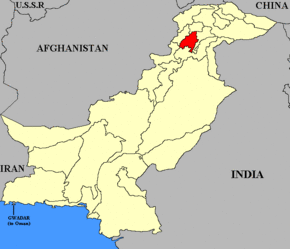History:Swat (princely state)
State of Swat حکومت خدايداد يوسفزي و متعلقات رياست سوات | |||||||||
|---|---|---|---|---|---|---|---|---|---|
| 1849–1969 | |||||||||
|
Flag | |||||||||
 Swat (higlighted) within the western part of the Dominion of Pakistan | |||||||||
| Status |
| ||||||||
| Capital | Saidu Sharif | ||||||||
| Official languages | |||||||||
| Government |
| ||||||||
| Wāli | |||||||||
• 1849–1857 | Akbar Shah | ||||||||
• 1857–1878 | Saidu Baba | ||||||||
• 1916–1918 | Abdul Jabbar Shah | ||||||||
• 1918–1949 | Miangul Abdul Wadud | ||||||||
• 1949–1969 | Miangul Jahan Zeb | ||||||||
| Historical era | Late modern Cold War | ||||||||
| 1849 | |||||||||
• Termination of subsidiary alliance | 15 August 1947 | ||||||||
| 3 November 1947 | |||||||||
• Dissolved | 28 July 1969 | ||||||||
| Currency |
| ||||||||
| Time zone | |||||||||
| |||||||||
| Today part of | Pakistan • Khyber Pakhtunkhwa | ||||||||
State of Swat (Urdu: رياست سوات), (Pashto: حکومت خداداد یوسفزئی و متعلقات) was a state established in 1849 by the Muslim saint Saidu Baba, also known as Akhund of Swat,[1][2] and was ruled by Walis of Swat. It was recognized as a princely state in alliance with the British Raj between 1918 and 1947, after which the Akhwand acceded to the newly independent state of Pakistan . Swat continued to exist as an autonomous region until it was dissolved in 1969,[3] and incorporated into Khyber Pakhtunkhwa province (formerly North-West Frontier Province). The area it covered is now divided among the present-day districts of Swat, Buner and Shangla.
History
The Swat state was established by a religious leader, Saidu Baba, who was born in Swat Valley in 1794. He began his life as a shepherd and then left the village at the age of 18 to settled in the village of Mian Brangola, where he got his early education and learnt the fundamentals of Islam.[4]
Saidu Baba ultimately settled in 1849 at Saidu Sharif, gradually turning Swat into an independent state.[5]:40 However, after his death in 1877, Swat fell into abeyance till 1915, when Abdul Jabbar, a descendant of Pir Baba was elected as leader. In 1918, the grandson of Saidu Baba, Miangul Abdul Wadud became the Wali of Swat. Soon Swat was recognized by the British government as a princely state. In 1947, Miangul Abdul Wadud acceded his state to Pakistan.
Government
The rulers of Swat held the title Amir-e Shariyat and from 1918 were known as Badshah; the title changed to Wali in 1926 when it became a Princely State of the British Raj. Since 1969 the former princely state has been under a civil administration as part of Khyber Pakhtunkhwa.[3]
| Tenure | Rulers of Swat |
|---|---|
| 1849–1857 | Akbar Shah |
| 1857–1878 | Saidu Baba |
| 1878–1916 | state in abeyance |
| 1916–1918 | Abdul Jabbar Shah |
| 1918–1949 | Miangul Abdul Wadud |
| 1949–1969 | Miangul Jahan Zeb |
See also
- Khyber Pakhtunkhwa
- List of buildings and structures built during the Swat (princely state)
- Princely states of Pakistan
References
- ↑ S.G. Page 398 and 399, T and C of N.W.F.P by Ibbetson page 11 etc
- ↑ Fredrik Barth, Features of Person and Society in Swat: Collected Essays on Pathans, illustrated edition, Routledge, 1981
- ↑ 3.0 3.1 Claus, Peter J.; Diamond, Sarah; Ann Mills, Margaret (2003). South Asian Folklore: An Encyclopedia : Afghanistan, Bangladesh, India, Nepal, Pakistan, Sri Lanka. Taylor & Francis. p. 447. ISBN 9780415939195. https://books.google.com/books?id=ienxrTPHzzwC&pg=PA447.
- ↑ Inam-ur-Rahim; Viaro, Alain M. (2002) (in en). Swat: An Afghan Society in Pakistan : Urbanisation and Change in Tribal Environment. City Press. pp. 77–79. ISBN 978-969-8380-55-7. https://books.google.com/books?id=p_9tAAAAMAAJ&q=akhund+jabrai.
- ↑ Haroon, Sana (2011). Frontier of Faith: Islam, in the Indo-Afghan Borderland. Hurst Publishers. ISBN 978-1849041836. https://books.google.com/books?id=f5uSeJCTvKoC&pg=PA42.
Further reading
- The Last Wali of Swat: An Autobiography as Told by Fredrik Barth (Asian Portraits), by Fredrik Barth
- Sack, John (2000). Report from Practically Nowhere. iUniverse. ISBN 0-595-08918-6.
- Sultan-i-Rome, Swat State, 1915–1969, From Genesis to Merger: An Analysis of Political, Administrative, Socio-Political, and Economic Development, Karachi: Oxford University Press (2008), ISBN:0-19-547113-X
- Sultan-i-Rome. Forestry in the Princely State of Swat and Kalam (North-West Pakistan): A Historical Perspective on Norms and Practices, NCCR IP6 Working Paper No. 6. Zurich: Department of Geography, University of Zurich (2005)
External links
 |


